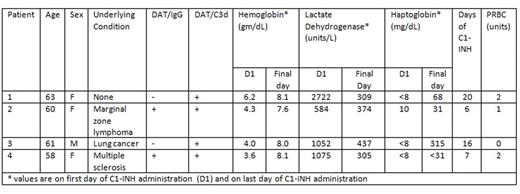
Autoimmune hemolytic anemia (AIHA) is defined as the development of autoantibodies against red blood cell (RBC) antigens. AIHA is diagnosed in the presence of hemolysis and a positive direct antiglobulin test (DAT) for IgG and/or complement C3d. AIHA is classified as warm, cold or mixed based on the temperature at which the autoantibody is most active. The most clinically severe anemia is usually associated with AIHA in which C3d is detected on DAT. The classical complement pathway is activated in AIHA when antigen-autoantibody complexes on the RBC surface bind to the complement protein C1q. This ultimately results in the generation of C3b. C3b is both an opsonin and an additional proteolytic enzyme. C3b deposition targets the RBC for phagocytosis by macrophages of the reticuloendothelial system resulting in extravascular hemolysis. C3b can also continue activation of complement on the RBC membrane resulting in formation of the membrane attack complex (MAC) and cell lysis. C3b is degraded into C3d, which is identified by the DAT (Bartolmas 2015). Severe anemia and its immediate consequences, the difficulty identifying suitable units for acute RBC transfusion, the likelihood of causing additional hemolysis as well as concerns for stimulating additional antibody production with transfusion make these patients particularly challenging to treat. Current standard treatment consists of steroids with or without rituximab. This treatment paradigm does not, however, address the acute and urgent management of life threatening anemia in many of these patients. C1 esterase inhibitor (C1-INH) is a member of the serine protease inhibitor family and interacts with C1 esterase to block activation of the classical pathway of complement. Case reports have demonstrated that C1-INH can prevent C3-mediated lysis of PNH erythrocytes (DeZern 2014) and augment survival of transfused RBCs in a patient with DAT C3d positive autoimmune hemolytic anemia (Wouters 2013). We hypothesized that minimizing or inhibiting the generation of C3b with C1-INH in patients with either severe cold autoantibody AIHA or a mixed AIHA would rapidly reduce acute hemolysis.
We report our clinical experience using a novel approach in the acute management of severe AIHA using the commercially available C1-INH, Berinert.
The four patients we identified with either cold or mixed AIHA (Table 1) were between the ages of 58 and 63. All patients presented with clinically severe anemia and required urgent management. Three of the 4 had a co-morbid condition associated with AIHA. All patients received prednisone (1mg/kg) and the commercially available C1-INH at a dose of 20mcg/kg daily from the day of admission for a minimum of 6 days to a maximum of 20 days. Patients 2, 3, and 4 also received 4 weekly doses of rituximab during the course of treatment. The average increase in mean hemoglobin was 79% (presentation mean 4.5gm/dL- end of C1-INH mean 7.95gm/dL) during C1-INH administration. An average of 1.25(0-2) units of packed RBC per patient were transfused during C1-INH administration. Additional measures of ongoing hemolysis including mean LDH which decreased by an average of 72% (presentation mean 1358u/L to end of C1-INH mean 356u/L) and mean haptoglobin which increased in all patients from < 8mg/dL to 111mg/dL after C1-INH. Of note, patient 1 had cold agglutinin titers measured prior to C1-INH administration at 1:128 and repeated after two days of C1-INH administration revealed a decrease to 1:32.
This retrospective review of patients demonstrates that utilizing C1-INH in conjunction with standard therapy is safe and results in rapid improvement of hemoglobin levels in patients with DAT/C3d positive AIHA. We hypothesize the inhibition of C1q-C4 interaction rapidly reduces C3b deposition on the RBC membrane decreasing both extra and intravascular RBC destruction. CI-INH therapy allowed successful management of these acutely ill patients with minimal RBC transfusions. We hypothesize that decreasing the exposure to additional antigenic stimulation may shorten the acute exacerbation of hemolysis. The optimal form and schedule of C1-INH therapy for AIHA remains to be determined. Based on these observations the role of inhibitors of the classical pathway of complement as both a single modality and in conjunction with standard therapy in the management of AIHA deserves further investigation.
Broome:Alexion Pharmaceuricals: Honoraria; True North Therapeutics: Honoraria.
Author notes
Asterisk with author names denotes non-ASH members.

This icon denotes a clinically relevant abstract


This feature is available to Subscribers Only
Sign In or Create an Account Close Modal